2 arrays
Download as PPT, PDF2 likes770 views
Arrays allow storing multiple values of the same type in contiguous memory locations. They are declared with the data type, name, and number of elements. Each element can then be accessed via its index number. Arrays must be initialized before use, which can be done by assigning values within curly brackets when declaring the array. Values in arrays can then be accessed and modified using indexing syntax like name[index].
1 of 20
Downloaded 60 times
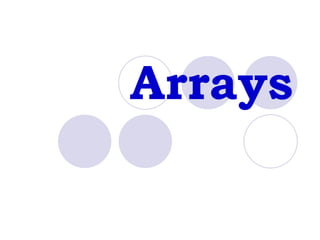
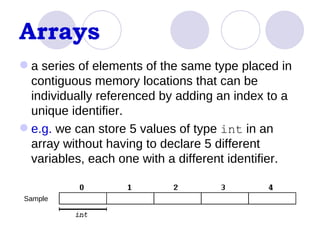
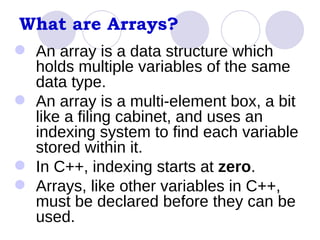
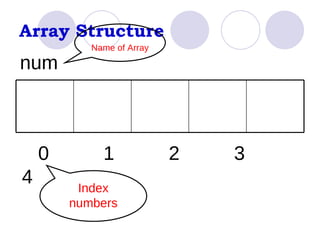
![Declaring an ARRAY General Syntax: type name [elements]; Where: type is a valid type (like int , float ...) name is a valid identifier elements field (which is always enclosed in square brackets [ ]), specifies how many of these elements the array has to contain.](https://image.slidesharecdn.com/2-arrays-100824091701-phpapp01/85/2-arrays-5-320.jpg)
![e.g. int sample [ 5 ]; The elements field within brackets [ ] which represents the number of elements the array is going to hold, must be a constant value, since arrays are blocks of non-dynamic memory whose size must be determined before execution. In order to create arrays with a variable length, dynamic memory is needed. Sample](https://image.slidesharecdn.com/2-arrays-100824091701-phpapp01/85/2-arrays-6-320.jpg)
![Declaring Arrays #include <iostream.h> void main() { int numbers[100]; int averages[]= {10,20,30}; numbers[0] = 10; }](https://image.slidesharecdn.com/2-arrays-100824091701-phpapp01/85/2-arrays-7-320.jpg)
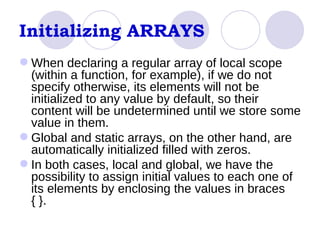
![int sample [5] = { 16, 2, 77, 40, 12071 }; The amount of values between braces { } must not be larger than the number of elements that we declare for the array between square brackets [ ]. When an initialization of values is provided for an array, C++ allows the possibility of leaving the square brackets empty [ ]. int sample [] = { 16, 2, 77, 40, 12071 }; 16 40 77 2 12071 Sample](https://image.slidesharecdn.com/2-arrays-100824091701-phpapp01/85/2-arrays-9-320.jpg)
![Initializing Arrays #include <iostream.h> main() { int count; int values[100]; for( count = 0; count < 100; count++ ) values[count] = 10; }](https://image.slidesharecdn.com/2-arrays-100824091701-phpapp01/85/2-arrays-10-320.jpg)
![Accessing the values of an ARRAY In any point of a program in which an array is visible, we can access the value of any of its elements individually as if it was a normal variable, thus being able to both read and modify its value. name[index] Sample[3] Sample[0] Sample[2] Sample[1] Sample[4] Sample](https://image.slidesharecdn.com/2-arrays-100824091701-phpapp01/85/2-arrays-11-320.jpg)
![e.g., to store the value 75 in the third element of sample: sample[2] = 75 e.g., to pass the value of the third element of sample to a variable called a: a = sample[2];](https://image.slidesharecdn.com/2-arrays-100824091701-phpapp01/85/2-arrays-12-320.jpg)
![An Array example int num[4]; num[0] = 101; num[1] = 232; num[2] = 231; num[3] = 0; The array num has a length of 4](https://image.slidesharecdn.com/2-arrays-100824091701-phpapp01/85/2-arrays-13-320.jpg)
![Square brackets [ ] perform two different tasks: to specify the size of arrays when they are declared; to specify indices for concrete array elements. int sample[5]; // declaration of a new Array sample[2] = 75; // access to an element of the Array.](https://image.slidesharecdn.com/2-arrays-100824091701-phpapp01/85/2-arrays-14-320.jpg)
![Some Valid Operations with Arrays sample[0] = a; sample[a] = 75; b = sample [a+2]; sample[sample[a]] = sample[2] + 5;](https://image.slidesharecdn.com/2-arrays-100824091701-phpapp01/85/2-arrays-15-320.jpg)
![Sample Implementation: // arrays example #include <iostream.h> int sample [] = {16, 2, 77, 40, 12071}; int n, result=0; int main () { for ( n=0 ; n<5 ; n++ ) {result += sample[n];} cout << result; return 0;}](https://image.slidesharecdn.com/2-arrays-100824091701-phpapp01/85/2-arrays-16-320.jpg)
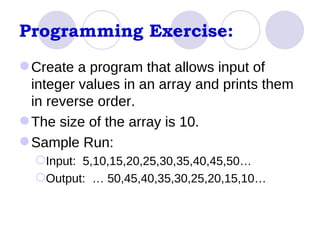

![Character Sequences the C++ Standard Library implements a powerful string class, which is very useful to handle and manipulate strings of characters. However, strings can also be represented as plain arrays of char elements. e.g. char sampchar [20];](https://image.slidesharecdn.com/2-arrays-100824091701-phpapp01/85/2-arrays-19-320.jpg)
![array of characters can store shorter sequences than its total length a special character is used to signal the end of the valid sequence: the null character , whose literal constant can be written as '\0' (backslash, zero). Hence, to initialize array of characters: char myword[] = { 'H', 'e', 'l', 'l', 'o', '\0' }; sampchar](https://image.slidesharecdn.com/2-arrays-100824091701-phpapp01/85/2-arrays-20-320.jpg)
Recommended
Array



ArrayHajar
Ã˝
An array allows us to store multiple values of the same data type using a single variable name. It represents the data contiguously in memory. We declare an array by specifying its type, name and size. Individual elements can be accessed using indexes and assigned values. Arrays can be passed to functions along with their size.One dimensional arrays



One dimensional arraysSatyam Soni
Ã˝
The document discusses one-dimensional arrays in C++. It defines an array as a group of like-type data where each element is referred to by an index. It describes how to declare arrays by specifying a type, name, and size. Elements in an array are accessed using subscript notation, with the first element having an index of 0. The document also covers initializing array elements either explicitly by assigning each one, or using an initialization list within braces.C++ programming (Array)



C++ programming (Array)طارق بالحارث
Ã˝
C++ arrays allow storing a fixed number of elements of the same type sequentially in memory. Arrays are declared by specifying the element type and number, such as int numbers[100]. Individual elements can then be accessed via their index like numbers[0]. Arrays can be initialized with a list of values or left uninitialized. Elements are accessed using their index and the array name, like n[5] to get the 6th element.C++ lecture 04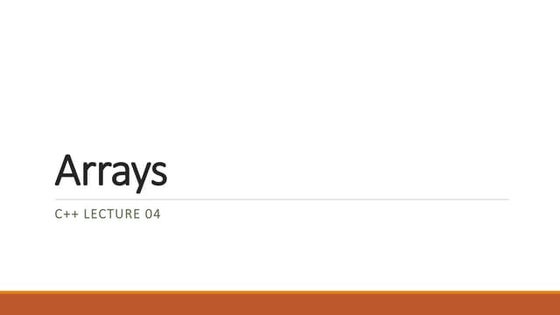



C++ lecture 04HNDE Labuduwa Galle
Ã˝
Arrays allow us to store multiple values of the same data type in memory. We can declare an array by specifying the data type, name, and number of elements. Individual elements can then be accessed using the name and index. Multidimensional arrays store arrays of arrays, representing tables of data. Arrays can also be passed as parameters to functions to operate on the array values. Strings are arrays of characters that end with a null terminator and can be initialized using character literals or double quotes.Programming in c Arrays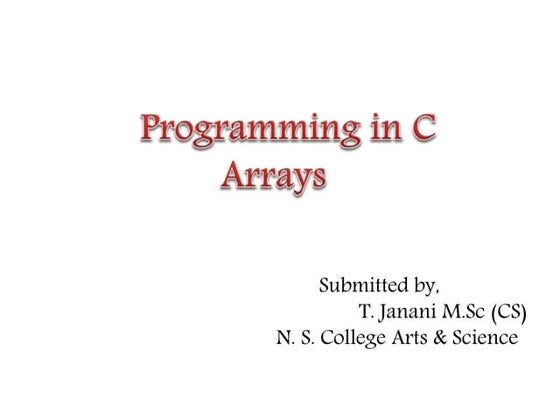



Programming in c Arraysjanani thirupathi
Ã˝
An array is a collection of data that holds a fixed number of values of the same type. Arrays allow storing multiple values in a single variable through indices. There are one-dimensional, two-dimensional, and multi-dimensional arrays. One-dimensional arrays use a single subscript, two-dimensional arrays use two subscripts like rows and columns, and multi-dimensional arrays can have more than two subscripts. Arrays can be initialized during declaration with values or initialized at runtime by user input or other methods. Elements are accessed using their indices and operations can be performed on the elements.Array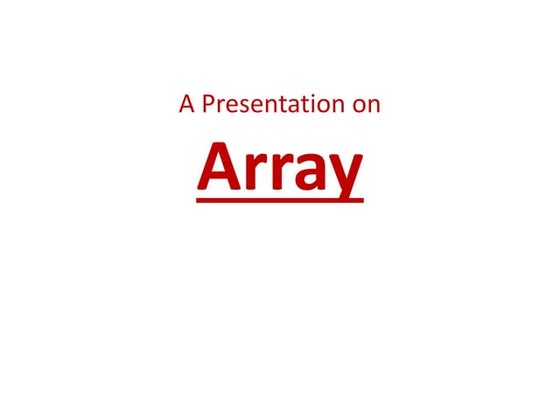



ArrayAnil Neupane
Ã˝
Arrays are a data structure that allow the storage of multiple elements of the same type. They can have one or more dimensions. One-dimensional arrays use a single subscript, while two-dimensional arrays use two subscripts to reference rows and columns. Arrays can be passed as arguments to functions in several ways, including as a pointer, sized array, or unsized array. Arrays are useful for storing and sorting data, performing matrix operations, and storing temporary values in recursive functions. However, arrays have limitations such as a static size, requiring elements to be of the same type, and potential memory issues if not sized correctly.Java: Introduction to Arrays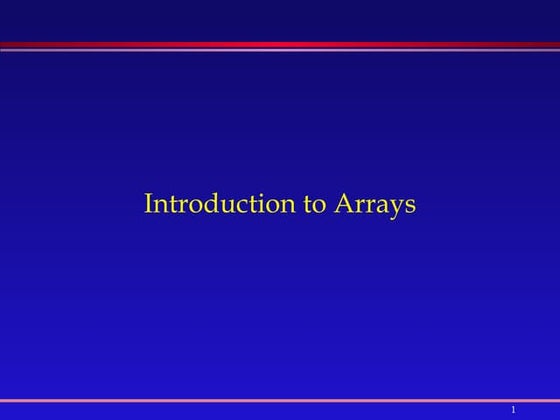



Java: Introduction to ArraysTareq Hasan
Ã˝
Sub: Java
Topic: Introduction to Arrays
∫›∫›fl£ number: 5
Presented by: Mahbubul Islam (MMI)
Lecturer, Dept. of CSE
University of RajshahiArrays in c language



Arrays in c languagetanmaymodi4
Ã˝
Arrays in C allow storing of homogeneous data items in contiguous memory locations. An array variable stores multiple data items of the same data type. Arrays provide advantages like code optimization through accessing elements with fewer lines of code, easy traversal and sorting of data using loops, and random access of any element. The main disadvantage is that arrays have a fixed size set at declaration. Key array terminology includes size, type, base address, index, and range. Arrays can be declared and initialized at the time of declaration or by taking input from the user. Multidimensional arrays like 2D arrays represent data in rows and columns like a matrix.SPL 10 | One Dimensional Array in C



SPL 10 | One Dimensional Array in CMohammad Imam Hossain
Ã˝
1. An array is a group of variables of the same type referred to by a common name. Arrays can have one or more dimensions.
2. A one-dimensional array stores elements in contiguous memory locations. Elements are accessed using an index number within square brackets.
3. Common array operations include initializing values, accessing individual elements, searching for elements, finding the maximum/minimum value, and performing element-wise operations on multiple arrays.Array Presentation



Array PresentationDeep Prajapati Microplacer
Ã˝
An array is a collection of data items, all of the same type, accessed using a common name. A one-dimensional array is like a list; A two dimensional array is like a table; The C language places no limits on the number of dimensions in an array, though specific implementations may.C++ Arrays



C++ Arraysأحمد محمد
Ã˝
An array is a collection of elements of the same type stored in contiguous memory locations that can be accessed using an index. Arrays allow storing multiple values as a single variable. One-dimensional arrays store elements in a list, while multi-dimensional arrays arrange elements in multiple dimensions. Elements are accessed using their position indices, which must be within the array bounds. Arrays can be initialized during declaration and values accessed using loops. Operations like input, output and searching are commonly performed on array elements.Arrays-Computer programming



Arrays-Computer programmingnmahi96
Ã˝
Arrays allow storing and accessing multiple values of the same data type. A two-dimensional array represents data in a tabular form and can be used to store values in a matrix. It is declared with two sets of brackets and initialized with nested curly braces. Elements are accessed using two indices, such as array[row][column]. Memory for a two-dimensional array is allocated in a contiguous block, with the first dimension iterating fastest.Programming in c arrays



Programming in c arraysUma mohan
Ã˝
This document discusses arrays in C programming. It defines an array as a collection of elements of the same type stored in contiguous memory locations. Arrays can be initialized either individually or with a single statement. Multi-dimensional arrays are also supported. Elements in an array are accessed via indexes, and pointers can also be used to access array elements. Various examples are provided to demonstrate declaring, initializing, accessing, and printing the values of single and multi-dimensional arrays in C.Passing an Array to a Function (ICT Programming)



Passing an Array to a Function (ICT Programming)Fatima Kate Tanay
Ã˝
Arrays passed to functions are passed by reference, not by value. When an array is passed to a function, the function receives the address of the first element. Any modifications made to the array elements inside the function are reflected in the original array in memory. Arrays do not need an ampersand (&) when passed to a function. The function prototype only needs to specify the array name without brackets to indicate an array parameter.Array Introduction One-dimensional array Multidimensional array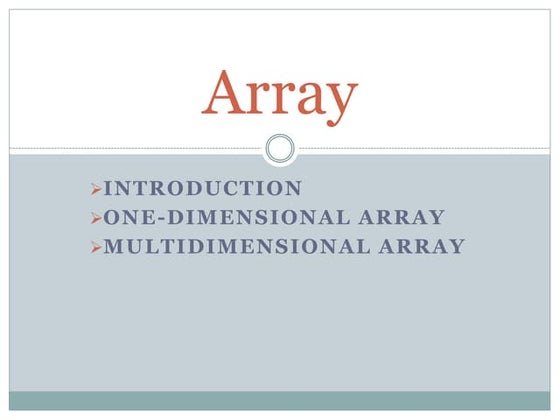



Array Introduction One-dimensional array Multidimensional arrayimtiazalijoono
Ã˝
Array
Introduction
One-dimensional array
Multidimensional array
Advantage of Array
Write a C program using arrays that produces the multiplication of two matrices.Array in c++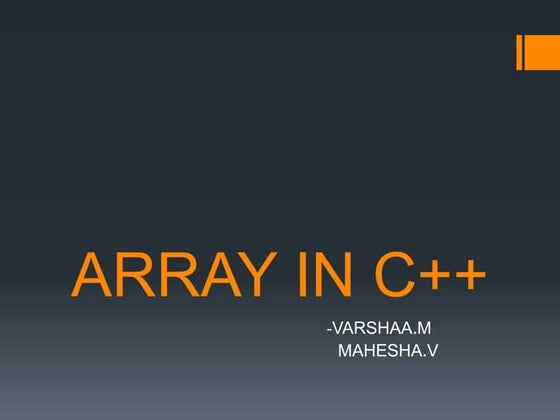



Array in c++Mahesha Mano
Ã˝
- An array is a collection of consecutive memory locations that all have the same name and type. An array allows storing multiple values of the same type using a single name.
- Arrays in C++ must be declared before use, specifying the type, name, and number of elements. Elements are accessed using an index.
- The main advantages of arrays are that they allow storing and processing large numbers of values efficiently using a single name. Arrays also make sorting and searching values easier.Array lecture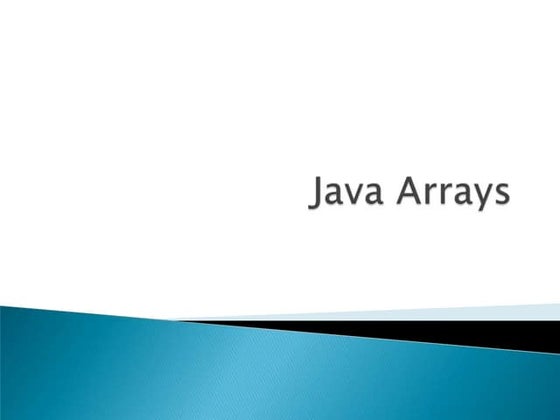



Array lectureJoan Saño
Ã˝
The document discusses arrays in Java. It defines arrays as variables that can store multiple values of the same type in contiguous memory locations. It describes how to declare, instantiate, initialize, access, and manipulate array elements. The key points covered are declaring arrays with the type[], accessing elements with indexes, initializing arrays during declaration, and setting and getting values at specific indexes.Arrays



ArraysKulachi Hansraj Model School Ashok Vihar
Ã˝
An array is a collection of variables of the same type stored in contiguous memory locations that can be accessed using a common name and a single index or subscript. Arrays allow storing and manipulating large number of similar data items efficiently. Some key points about arrays are that they are derived data types, consist of contiguous memory locations, and can store fundamental and user-defined data types.Arrays in C language



Arrays in C languageShubham Sharma
Ã˝
This document discusses arrays in the C programming language. It begins by defining an array as a collection of elements of the same data type. It then covers key topics such as declaring and initializing one-dimensional and multi-dimensional arrays, accessing array elements using indexes, and performing input and output operations on arrays. Examples are provided to demonstrate how to declare, initialize, read from, and print arrays. The document serves as an introduction to working with arrays in C.Arrays



ArraysTrupti Agrawal
Ã˝
Arrays are a commonly used data structure that store multiple elements of the same type. Elements in an array are accessed using subscripts or indexes, with the first element having an index of 0. Multidimensional arrays can store elements in rows and columns, accessed using two indexes. Arrays are stored linearly in memory in either row-major or column-major order, which affects how elements are accessed.02 c++ Array Pointer



02 c++ Array PointerTareq Hasan
Ã˝
The document discusses arrays and pointers in C++. It covers:
- How to declare and initialize arrays
- Accessing array elements using subscripts
- Using parallel arrays when subscripts are not sequential numbers
- Special considerations for strings as arrays of characters
- Declaring pointer variables and using pointers to access array elements
- Potential issues with pointers like dangling referencesArray and string



Array and stringprashant chelani
Ã˝
The document discusses arrays and strings in C programming. It defines arrays as groups of data items of the same type that share a common name. One-dimensional arrays are declared with a datatype and size, and can be initialized. Multi-dimensional arrays have multiple subscripts. Strings are arrays of characters that are null-terminated. Strings can be initialized and manipulated using functions like strcpy(), strlen(), strcmp(). Examples are provided to demonstrate array and string declarations, initialization, manipulation and differences between the two data structures.Array C programming



Array C programmingPrionto Abdullah
Ã˝
This document provides an introduction and overview of arrays in C programming. It defines an array as a collection of the same type of data. It describes how to declare and initialize single-dimensional and two-dimensional arrays, including examples. It also provides simple programs to demonstrate summing values in a single-dimensional array and outputting values in a two-dimensional array.Arrays in java language



Arrays in java languageHareem Naz
Ã˝
An array in Java is a group of variables of the same type that can store multiple values. Arrays are created using syntax like int[] arrayName = new int[size]; and values are assigned to elements in the array using indexes that start from 0. For example, an int array of size 4 could be initialized with values through arrayName[0]=1; arrayName[1]=22; etc. The document also provides a short Java program example to demonstrate printing the values of an int array.Unit 6. Arrays



Unit 6. ArraysAshim Lamichhane
Ã˝
Introduction of arrays, Declaration of array, Initialization of array, Sorting, Multidimensional array. Some code examples that will make you clear about the concept of arrays.
https://github.com/ashim888/csit-cOne dimensional 2



One dimensional 2Rajendran
Ã˝
1. Arrays are structured data types that allow storing and accessing related data elements by index.
2. A one-dimensional array stores elements of the same type and provides indexed access to individual elements.
3. Arrays in C++ must be declared with a size and individual elements can only be accessed by integer indices corresponding to their position in the array.Chap09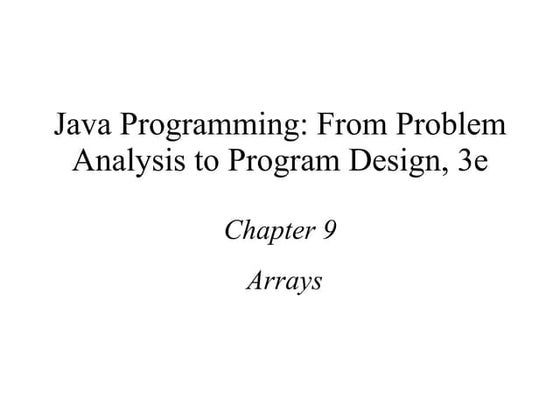



Chap09Terry Yoast
Ã˝
The document discusses arrays in Java programming. It covers topics like declaring and initializing one-dimensional and multi-dimensional arrays, processing array data through loops and methods, and common operations on arrays like initialization, input, output, and finding maximum/minimum values. The document also discusses passing arrays as parameters to methods and using arrays to store objects.Array



ArrayPRN USM
Ã˝
The document discusses arrays in Java. It begins by defining what an array is - a structured data type that stores a fixed number of elements of the same type. It then covers how to declare and initialize one-dimensional arrays, manipulate array elements using loops and indexes, and how to pass arrays as parameters to methods. The document also discusses arrays of objects and multidimensional arrays.Presentation about arrays



Presentation about arraysslave of Allah
Ã˝
The document discusses one-dimensional arrays, including their declaration, initialization, and uses. It notes that arrays allow storing multiple values in a single variable. Arrays can be initialized at compile-time by providing values between curly brackets, or at runtime by iterating through each element with a for loop. Examples are provided of initializing arrays with integer, float, and character values both at compile-time and runtime.Arrays



Arraysfahadshakeel
Ã˝
The document outlines arrays and provides examples of declaring, initializing, and using arrays in C++ programs. It discusses declaring arrays with a specified size and type, initializing arrays using for loops or initializer lists, passing arrays to functions, and searching and sorting array elements. Examples demonstrate initializing arrays, outputting array contents, computing operations on array elements, and using arrays to count outcomes from rolling dice simulations.More Related Content
What's hot (20)
SPL 10 | One Dimensional Array in C



SPL 10 | One Dimensional Array in CMohammad Imam Hossain
Ã˝
1. An array is a group of variables of the same type referred to by a common name. Arrays can have one or more dimensions.
2. A one-dimensional array stores elements in contiguous memory locations. Elements are accessed using an index number within square brackets.
3. Common array operations include initializing values, accessing individual elements, searching for elements, finding the maximum/minimum value, and performing element-wise operations on multiple arrays.Array Presentation



Array PresentationDeep Prajapati Microplacer
Ã˝
An array is a collection of data items, all of the same type, accessed using a common name. A one-dimensional array is like a list; A two dimensional array is like a table; The C language places no limits on the number of dimensions in an array, though specific implementations may.C++ Arrays



C++ Arraysأحمد محمد
Ã˝
An array is a collection of elements of the same type stored in contiguous memory locations that can be accessed using an index. Arrays allow storing multiple values as a single variable. One-dimensional arrays store elements in a list, while multi-dimensional arrays arrange elements in multiple dimensions. Elements are accessed using their position indices, which must be within the array bounds. Arrays can be initialized during declaration and values accessed using loops. Operations like input, output and searching are commonly performed on array elements.Arrays-Computer programming



Arrays-Computer programmingnmahi96
Ã˝
Arrays allow storing and accessing multiple values of the same data type. A two-dimensional array represents data in a tabular form and can be used to store values in a matrix. It is declared with two sets of brackets and initialized with nested curly braces. Elements are accessed using two indices, such as array[row][column]. Memory for a two-dimensional array is allocated in a contiguous block, with the first dimension iterating fastest.Programming in c arrays



Programming in c arraysUma mohan
Ã˝
This document discusses arrays in C programming. It defines an array as a collection of elements of the same type stored in contiguous memory locations. Arrays can be initialized either individually or with a single statement. Multi-dimensional arrays are also supported. Elements in an array are accessed via indexes, and pointers can also be used to access array elements. Various examples are provided to demonstrate declaring, initializing, accessing, and printing the values of single and multi-dimensional arrays in C.Passing an Array to a Function (ICT Programming)



Passing an Array to a Function (ICT Programming)Fatima Kate Tanay
Ã˝
Arrays passed to functions are passed by reference, not by value. When an array is passed to a function, the function receives the address of the first element. Any modifications made to the array elements inside the function are reflected in the original array in memory. Arrays do not need an ampersand (&) when passed to a function. The function prototype only needs to specify the array name without brackets to indicate an array parameter.Array Introduction One-dimensional array Multidimensional array



Array Introduction One-dimensional array Multidimensional arrayimtiazalijoono
Ã˝
Array
Introduction
One-dimensional array
Multidimensional array
Advantage of Array
Write a C program using arrays that produces the multiplication of two matrices.Array in c++



Array in c++Mahesha Mano
Ã˝
- An array is a collection of consecutive memory locations that all have the same name and type. An array allows storing multiple values of the same type using a single name.
- Arrays in C++ must be declared before use, specifying the type, name, and number of elements. Elements are accessed using an index.
- The main advantages of arrays are that they allow storing and processing large numbers of values efficiently using a single name. Arrays also make sorting and searching values easier.Array lecture



Array lectureJoan Saño
Ã˝
The document discusses arrays in Java. It defines arrays as variables that can store multiple values of the same type in contiguous memory locations. It describes how to declare, instantiate, initialize, access, and manipulate array elements. The key points covered are declaring arrays with the type[], accessing elements with indexes, initializing arrays during declaration, and setting and getting values at specific indexes.Arrays



ArraysKulachi Hansraj Model School Ashok Vihar
Ã˝
An array is a collection of variables of the same type stored in contiguous memory locations that can be accessed using a common name and a single index or subscript. Arrays allow storing and manipulating large number of similar data items efficiently. Some key points about arrays are that they are derived data types, consist of contiguous memory locations, and can store fundamental and user-defined data types.Arrays in C language



Arrays in C languageShubham Sharma
Ã˝
This document discusses arrays in the C programming language. It begins by defining an array as a collection of elements of the same data type. It then covers key topics such as declaring and initializing one-dimensional and multi-dimensional arrays, accessing array elements using indexes, and performing input and output operations on arrays. Examples are provided to demonstrate how to declare, initialize, read from, and print arrays. The document serves as an introduction to working with arrays in C.Arrays



ArraysTrupti Agrawal
Ã˝
Arrays are a commonly used data structure that store multiple elements of the same type. Elements in an array are accessed using subscripts or indexes, with the first element having an index of 0. Multidimensional arrays can store elements in rows and columns, accessed using two indexes. Arrays are stored linearly in memory in either row-major or column-major order, which affects how elements are accessed.02 c++ Array Pointer



02 c++ Array PointerTareq Hasan
Ã˝
The document discusses arrays and pointers in C++. It covers:
- How to declare and initialize arrays
- Accessing array elements using subscripts
- Using parallel arrays when subscripts are not sequential numbers
- Special considerations for strings as arrays of characters
- Declaring pointer variables and using pointers to access array elements
- Potential issues with pointers like dangling referencesArray and string



Array and stringprashant chelani
Ã˝
The document discusses arrays and strings in C programming. It defines arrays as groups of data items of the same type that share a common name. One-dimensional arrays are declared with a datatype and size, and can be initialized. Multi-dimensional arrays have multiple subscripts. Strings are arrays of characters that are null-terminated. Strings can be initialized and manipulated using functions like strcpy(), strlen(), strcmp(). Examples are provided to demonstrate array and string declarations, initialization, manipulation and differences between the two data structures.Array C programming



Array C programmingPrionto Abdullah
Ã˝
This document provides an introduction and overview of arrays in C programming. It defines an array as a collection of the same type of data. It describes how to declare and initialize single-dimensional and two-dimensional arrays, including examples. It also provides simple programs to demonstrate summing values in a single-dimensional array and outputting values in a two-dimensional array.Arrays in java language



Arrays in java languageHareem Naz
Ã˝
An array in Java is a group of variables of the same type that can store multiple values. Arrays are created using syntax like int[] arrayName = new int[size]; and values are assigned to elements in the array using indexes that start from 0. For example, an int array of size 4 could be initialized with values through arrayName[0]=1; arrayName[1]=22; etc. The document also provides a short Java program example to demonstrate printing the values of an int array.Unit 6. Arrays



Unit 6. ArraysAshim Lamichhane
Ã˝
Introduction of arrays, Declaration of array, Initialization of array, Sorting, Multidimensional array. Some code examples that will make you clear about the concept of arrays.
https://github.com/ashim888/csit-cOne dimensional 2



One dimensional 2Rajendran
Ã˝
1. Arrays are structured data types that allow storing and accessing related data elements by index.
2. A one-dimensional array stores elements of the same type and provides indexed access to individual elements.
3. Arrays in C++ must be declared with a size and individual elements can only be accessed by integer indices corresponding to their position in the array.Chap09



Chap09Terry Yoast
Ã˝
The document discusses arrays in Java programming. It covers topics like declaring and initializing one-dimensional and multi-dimensional arrays, processing array data through loops and methods, and common operations on arrays like initialization, input, output, and finding maximum/minimum values. The document also discusses passing arrays as parameters to methods and using arrays to store objects.Array



ArrayPRN USM
Ã˝
The document discusses arrays in Java. It begins by defining what an array is - a structured data type that stores a fixed number of elements of the same type. It then covers how to declare and initialize one-dimensional arrays, manipulate array elements using loops and indexes, and how to pass arrays as parameters to methods. The document also discusses arrays of objects and multidimensional arrays.Viewers also liked (20)
Presentation about arrays



Presentation about arraysslave of Allah
Ã˝
The document discusses one-dimensional arrays, including their declaration, initialization, and uses. It notes that arrays allow storing multiple values in a single variable. Arrays can be initialized at compile-time by providing values between curly brackets, or at runtime by iterating through each element with a for loop. Examples are provided of initializing arrays with integer, float, and character values both at compile-time and runtime.Arrays



Arraysfahadshakeel
Ã˝
The document outlines arrays and provides examples of declaring, initializing, and using arrays in C++ programs. It discusses declaring arrays with a specified size and type, initializing arrays using for loops or initializer lists, passing arrays to functions, and searching and sorting array elements. Examples demonstrate initializing arrays, outputting array contents, computing operations on array elements, and using arrays to count outcomes from rolling dice simulations.Data structure Stack



Data structure StackPraveen Vishwakarma
Ã˝
This document provides information about stacks as a data structure. It defines a stack as a linear data structure that only allows additions or deletions at one end, following the last-in, first-out (LIFO) principle. The key operations on a stack are push, which adds an element to the top, and pop, which removes an element from the top. The document also discusses stack terminology, different types of notations for expressions (infix, prefix, postfix), algorithms for converting between notations using a stack, an example C program for implementing a stack using an array, and summarizes the main characteristics of stacks.Response To Intervention



Response To InterventionPaul Schumann
Ã˝
1) RtI is a multi-tiered framework that provides high-quality instruction and interventions matched to student needs, as identified by ongoing assessment. Within RtI, there is collaboration between district programs and personnel.
2) Tier 1 involves school-wide screening to identify students who may need extra support and delivers effective, differentiated classroom instruction to all students using evidence-based practices. Progress is monitored to determine students' responses to instruction.
3) If students do not make adequate progress in Tier 1, they advance to Tier 2 which provides more intensive, targeted interventions in addition to the core curriculum. Interventions are implemented with fidelity and based on ongoing collection and analysis of student data.Math grade 2 training



Math grade 2 trainingAnthony Smith
Ã˝
The document provides guidance for teachers administering 2nd grade math performance assessments aligned to Common Core standards. It explains that assessments will be administered in September (pre) and May-June (post) and scored using an online system called LinkIt. It provides instructions for logging into LinkIt and outlines which assessment tasks should be administered individually versus to the whole class. Rubrics will be used to score student performance on each task.Grade 2 module 6 pd Katrice Hall



Grade 2 module 6 pd Katrice HallKatrice Hall
Ã˝
This document provides an agenda and resources for a teacher training on implementing a second grade math curriculum. The training will include a gallery walk to discuss strengths and weaknesses of previous modules, an overview of the current Module 6 which focuses on foundations of multiplication and division using equal groups and arrays, teaching a sample lesson, and an open discussion forum. Resources like websites and a video are also listed to support teaching the new concepts.Dll esp 2



Dll esp 2Mary Ann Encinas
Ã˝
This document contains a daily log of lesson plans for Edukasyon sa Pagpapakatao 2 (Education for Self-Enhancement 2) for the first quarter. Each entry outlines the daily lesson objective which remains the same throughout, references the relevant pages in the teacher's guide and learner's textbooks. It also includes remarks on the number of learners who achieved mastery of the lesson and those who needed remediation or reinforcement, as well as notes on other classroom activities.Dll GRADE 2 MATH



Dll GRADE 2 MATHMary Ann Encinas
Ã˝
This document contains a daily log of lesson plans for a mathematics class in the Philippines from June to July. Each day lists the objectives, references from textbooks and guides, and remarks. The objectives cover number recognition, counting, addition, word problems, and place value for numbers up to 1,000. The remarks section tracks the number of students meeting mastery levels and needing remediation. Other activities are also sometimes noted. The log shows the planned curriculum and assessment for the class over this time period.Stack Data structure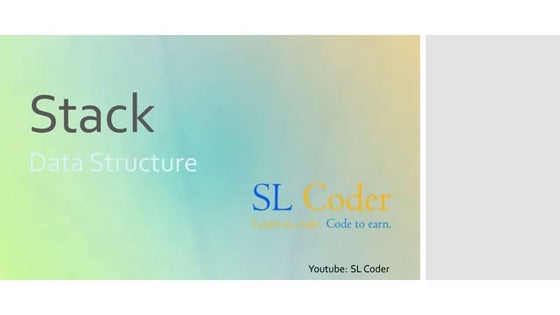



Stack Data structureB Liyanage Asanka
Ã˝
This document provides an overview of stacks as a data structure. It defines stacks as linear structures that store data in a last-in, first-out manner. Key points covered include common stack operations like push and pop, complexity analysis, examples of where stacks are used, and C++ code for implementing a stack class with methods like push, pop, peek, and isEmpty.K to 12 Grade 2 DLL MOTHER TONGUE BASED (Q1 – Q4)



K to 12 Grade 2 DLL MOTHER TONGUE BASED (Q1 – Q4)LiGhT ArOhL
Ã˝
NOTE:
I’m not the owner of this DLL, just downloaded and shared it to u also. Maybe it will help u too. Credit to the original owner!Mission Impossible Part 2 EsP 8 Modyul 2



Mission Impossible Part 2 EsP 8 Modyul 2Edna Azarcon
Ã˝
Lessons in EsP 8 (Pagpapalalim Part 2 with Narration)K to 12 Grade 2 DLL Filipino (Q1 – Q4)



K to 12 Grade 2 DLL Filipino (Q1 – Q4)LiGhT ArOhL
Ã˝
This document contains a daily log of lesson plans for Filipino 2 taught during the first quarter. It includes the learning objectives, references from the teacher's guide and learner's materials, and remarks for each class from June 2 to July 18. The objectives focus on identifying words and concepts, applying grammar rules, summarizing texts, and practicing writing skills. The remarks provide the number of learners who achieved mastery of the objectives and those who needed remediation or reinforcement activities for each lesson.Banghay aralin sa edukasyon sa pagpapakatao 9



Banghay aralin sa edukasyon sa pagpapakatao 9Jacobo Z. Gonzales Memorial National High School
Ã˝
Kindly check na lang po, ito po yung ginamit ko noong nakaraang panuruang taon 2015. (not completed kase naibigay ko na yung lesson plan ko sa friend ko)K to 12 Araling Panlipunan Grade 2 (4th Quarter 1st Summative Test)



K to 12 Araling Panlipunan Grade 2 (4th Quarter 1st Summative Test)LiGhT ArOhL
Ã˝
This is sample of 1st Summative test in Araling Panlipunan II for the 4th Quarter.K to 12 Araling Panlipunan Grade 2 (3rd Periodical Exam)



K to 12 Araling Panlipunan Grade 2 (3rd Periodical Exam)LiGhT ArOhL
Ã˝
Third Periodical Test in Araling Panlipunan Grade 2 K to 12
Note: I just copied it from my daughter's exam and upload it to here for some reference. K to 12 ENGLISH Grade 2 (4th Quarter 1st Summative Test)



K to 12 ENGLISH Grade 2 (4th Quarter 1st Summative Test)LiGhT ArOhL
Ã˝
This document contains a 1st summative test in English for 2nd grade students. It has three sections that assess writing skills, story sequencing, and punctuation. The first section asks students to fill in blanks with words like "put on", "try on", and "take off" to complete sentences about putting on and taking off clothes. The second section provides a short story and asks students to number sentences in the correct order and answer questions about details. The third section presents sentences for students to add the appropriate punctuation marks. The test is intended to evaluate students' English skills in the 4th quarter of their 2nd grade year.Similar to 2 arrays (20)
Arrays



ArraysNotre Dame of Midsayap College
Ã˝
The document discusses one-dimensional and two-dimensional arrays in C++. It defines an array as a series of elements of the same type that allows storing multiple values of that type. For one-dimensional arrays, it covers declaring, initializing, and accessing arrays using indexes. Two-dimensional arrays are defined as arrays of arrays, representing a table with rows and columns where each element is accessed using row and column indexes. The document provides examples of declaring, initializing, and accessing elements in one-dimensional and two-dimensional arrays in C++.Array and its types and it's implemented programming Final.pdf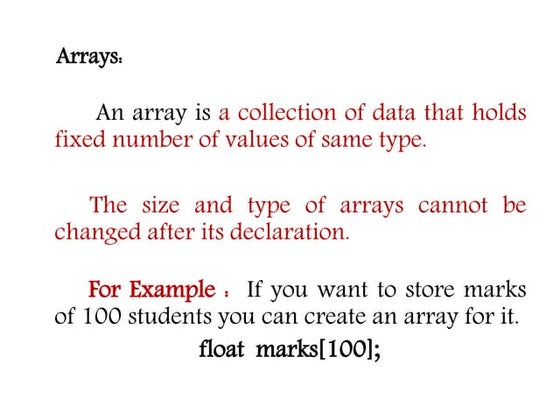



Array and its types and it's implemented programming Final.pdfajajkhan16
Ã˝
Arrays allow storing multiple values of the same type. An array has a fixed size that is declared and cannot be changed. Elements within an array are accessed via indices from 0 to size-1. Multidimensional arrays can represent tables of data and are arrays of arrays.Arrays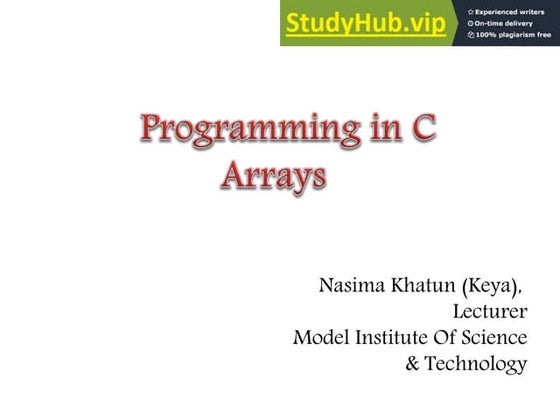



ArraysSteven Wallach
Ã˝
1. An array is a collection of data that holds a fixed number of values of the same type. Arrays allow storing multiple values in a single variable.
2. Arrays can have one dimension (1D), two dimensions (2D), or more dimensions. A 1D array stores values in a list, while a 2D array can be thought of as a table with rows and columns.
3. Array elements can be accessed using indices, with the first element having index 0. The last element of an array of size n has index n-1. Arrays must be initialized before use to assign starting values to elements.Array



Arrayhjasjhd
Ã˝
The document discusses C arrays and multi-dimensional arrays. It defines arrays as a collection of related data items represented by a single variable name. Arrays must be declared before use with the general form of "type variablename[size]". Elements are accessed via indexes from 0 to size-1. The document also discusses initializing arrays, multi-dimensional arrays with two or more subscripts to represent rows and columns, and provides examples of declaring and initializing multi-dimensional arrays in C.Arrays



ArraysVenkataRangaRaoKommi1
Ã˝
An array is a collection of data that holds a fixed number of values of the same type. Arrays allow storing multiple values in a single variable through indices. There are one-dimensional, two-dimensional, and multi-dimensional arrays. One-dimensional arrays use a single subscript, two-dimensional arrays use two subscripts like rows and columns, and multi-dimensional arrays can have more than two subscripts. Arrays can be initialized during declaration with values or initialized at runtime by user input or other methods. Elements are accessed using their indices and operations can be performed on the elements.Chapter-Five.pptx



Chapter-Five.pptxberekethailu2
Ã˝
This document discusses arrays and strings in C++. It defines an array as a collection of identical data objects stored in consecutive memory locations under a common name. Arrays allow storing multiple values of the same type using one variable name. Strings are represented using arrays of character type (char). Strings are terminated with a null character (\0) to indicate the end of the valid characters. Arrays and strings can be initialized using individual values or constant strings enclosed in double quotes. Arrays and strings share properties like indexing elements from 0 to size-1.Introduction to Arrays in C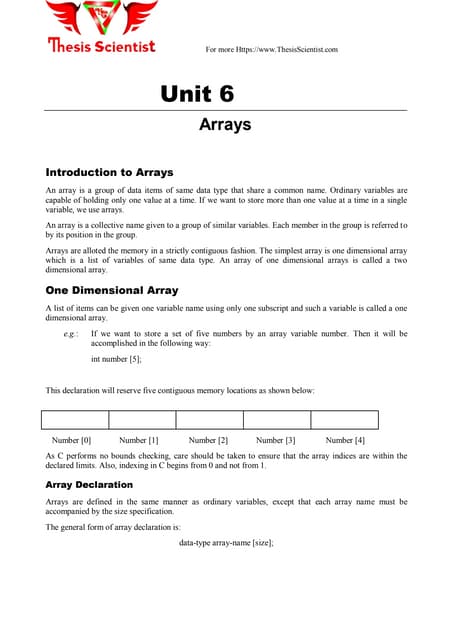



Introduction to Arrays in CThesis Scientist Private Limited
Ã˝
An array is a group of data items of same data type that share a common name. Ordinary variables are capable of holding only one value at a time. If we want to store more than one value at a time in a single variable, we use arrays.
An array is a collective name given to a group of similar variables. Each member in the group is referred to by its position in the group.
Arrays are alloted the memory in a strictly contiguous fashion. The simplest array is a one-dimensional array which is a list of variables of same data type. An array of one-dimensional arrays is called a two-dimensional array.Arrays & Strings



Arrays & StringsMunazza-Mah-Jabeen
Ã˝
Arrays & Strings can be summarized as follows:
1. Arrays are fixed-size collections of elements of the same data type that are used to store lists of related data. They can be one-dimensional, two-dimensional, or multi-dimensional.
2. Strings in C are arrays of characters terminated by a null character. They are commonly used to store text data. Common string operations include reading, writing, combining, copying, comparing, and extracting portions of strings.
3. Arrays are declared with a data type, name, and size. They can be initialized with a block of comma-separated values. Individual elements are accessed using indexes in square brackets. Two-dimensional arrays represent tablesArrays in programming



Arrays in programmingTaseerRao
Ã˝
The document provides an overview of arrays in Java, including:
- Arrays can hold multiple values of the same type, unlike primitive variables which can only hold one value.
- One-dimensional arrays use a single index, while multi-dimensional arrays use two or more indices.
- Elements in an array are accessed using their index number, starting from 0.
- The size of an array is set when it is declared and cannot be changed, but reference variables can point to different arrays.
- Common operations on arrays include initializing values, accessing elements, looping through elements, and copying arrays.Array&string



Array&stringchanchal ghosh
Ã˝
The document discusses various aspects of arrays in C programming language. It defines arrays as collections of similar data types stored in contiguous memory locations. It describes single dimensional and multi-dimensional arrays. It also discusses array declaration and initialization syntax. Some key points covered are: advantages of arrays over single variables, accessing array elements using indexes, passing arrays to functions, and two dimensional or 2D arrays also called matrices.Homework Assignment – Array Technical DocumentWrite a technical .pdf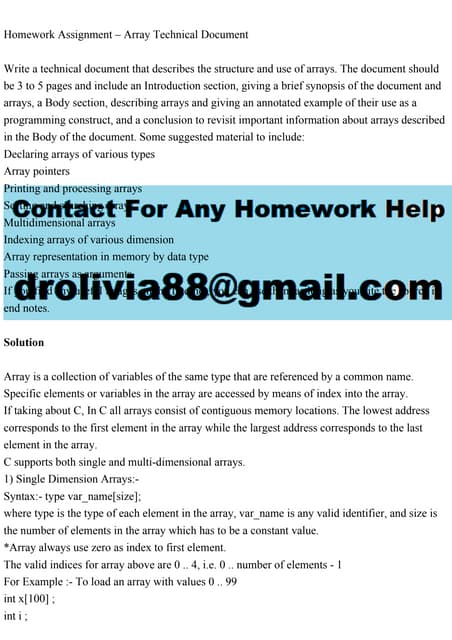



Homework Assignment – Array Technical DocumentWrite a technical .pdfaroraopticals15
Ã˝
Homework Assignment – Array Technical Document
Write a technical document that describes the structure and use of arrays. The document should
be 3 to 5 pages and include an Introduction section, giving a brief synopsis of the document and
arrays, a Body section, describing arrays and giving an annotated example of their use as a
programming construct, and a conclusion to revisit important information about arrays described
in the Body of the document. Some suggested material to include:
Declaring arrays of various types
Array pointers
Printing and processing arrays
Sorting and searching arrays
Multidimensional arrays
Indexing arrays of various dimension
Array representation in memory by data type
Passing arrays as arguments
If you find any useful images on the Internet, you can use them as long as you cite the source in
end notes.
Solution
Array is a collection of variables of the same type that are referenced by a common name.
Specific elements or variables in the array are accessed by means of index into the array.
If taking about C, In C all arrays consist of contiguous memory locations. The lowest address
corresponds to the first element in the array while the largest address corresponds to the last
element in the array.
C supports both single and multi-dimensional arrays.
1) Single Dimension Arrays:-
Syntax:- type var_name[size];
where type is the type of each element in the array, var_name is any valid identifier, and size is
the number of elements in the array which has to be a constant value.
*Array always use zero as index to first element.
The valid indices for array above are 0 .. 4, i.e. 0 .. number of elements - 1
For Example :- To load an array with values 0 .. 99
int x[100] ;
int i ;
for ( i = 0; i < 100; i++ )
x[i] = i ;
To determine to size of an array at run time the sizeof operator is used. This returns the size in
bytes of its argument. The name of the array is given as the operand
size_of_array = sizeof ( array_name ) ;
2) Initialisg array:-
Arrays can be initialised at time of declaration in the following manner.
type array[ size ] = { value list };
For Example :-
int i[5] = {1, 2, 3, 4, 5 } ;
i[0] = 1, i[1] = 2, etc.
The size specification in the declaration may be omitted which causes the compiler to count the
number of elements in the value list and allocate appropriate storage.
For Example :- int i[ ] = { 1, 2, 3, 4, 5 } ;
3) Multidimensional array:-
Multidimensional arrays of any dimension are possible in C but in practice only two or three
dimensional arrays are workable. The most common multidimensional array is a two
dimensional array for example the computer display, board games, a mathematical matrix etc.
Syntax :type name [ rows ] [ columns ] ;
For Example :- 2D array of dimension 2 X 3.
int d[ 2 ] [ 3 ] ;
A two dimensional array is actually an array of arrays, in the above case an array of two integer
arrays (the rows) each with three elements, and is stored row-wise in memory.
For Example :- Program to fill .Lecture 7



Lecture 7Mohammed Khan
Ã˝
The objective of the Level 5 Diploma in Information Technology is to provide learners with an excellent foundation for a career in a range of organisations. It designed to ensure that each learner is ‘business ready’: a confident, independent thinker with a detailed knowledge of Information Technology, and equipped with the skills to adapt rapidly to change.Arrays and Strings 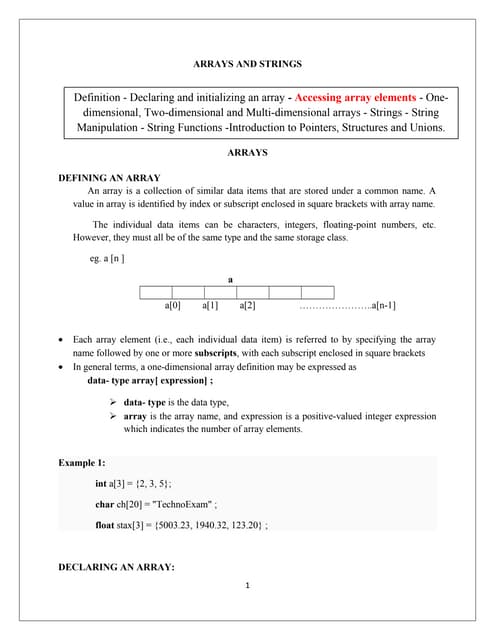



Arrays and Strings Dr.Subha Krishna
Ã˝
1. Arrays allow storing of multiple elements of the same data type under a single name. They can be one-dimensional, two-dimensional, or multi-dimensional. Strings are arrays of characters terminated by a null character.
2. Common array operations include declaring and initializing arrays, accessing elements using indexes, and performing element-by-element operations. Strings have specialized functions for operations like length calculation, copying, comparison and concatenation.
3. Pointers allow working with arrays by reference rather than value and are useful for passing arrays to functions. Structures group together different data types under one name and unions allow storing different data types in the same memory space.Algo>Arrays



Algo>ArraysAin-ul-Moiz Khawaja
Ã˝
Arrays are ordered sets of elements of the same type that allow direct access to each element through an index. In C++, arrays have a fixed size that is declared, with elements accessed using square brackets and integers representing their position. Multidimensional arrays arrange data in tables and can be thought of as arrays of arrays. Elements are accessed using multiple indices separated by commas within the brackets.ARRAYS



ARRAYSmuniryaseen
Ã˝
C programming language allows for the declaration of arrays, which can store a fixed number of elements of the same data type. Arrays provide an efficient way to store and access related data sequentially in memory. Individual elements in an array are accessed via an index, and multi-dimensional arrays can model tables of data with multiple indices to access each element.Arrays in Data Structure and Algorithm 



Arrays in Data Structure and Algorithm KristinaBorooah
Ã˝
This is a presentation on Arrays, one of the most important topics on Data Structures and algorithms. Anyone who is new to DSA or wants to have a theoretical understanding of the same can refer to it :DChyuuuuuuuuuuryyyyyyyyyyy123456789786341.pptx



Chyuuuuuuuuuuryyyyyyyyyyy123456789786341.pptxRobertCarreonBula
Ã˝
Chyuuuuuuuuuuryyyyyyyyyyy123456789786341.pptxArrays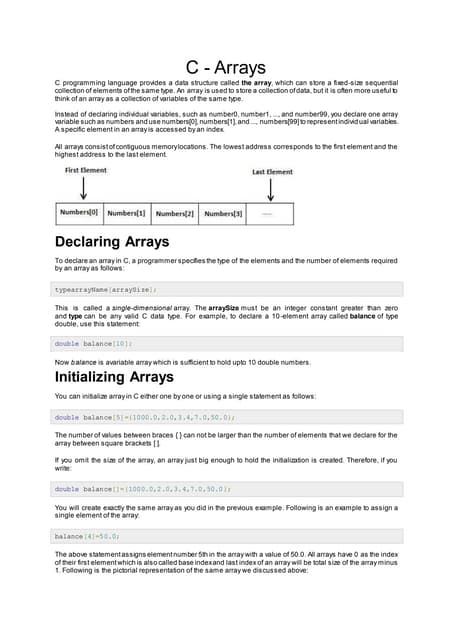



ArraysChukka Nikhil Chakravarthy
Ã˝
C programming language provides arrays as a data structure to store a fixed-size collection of elements of the same type. An array stores elements in contiguous memory locations. Individual elements in an array can be accessed using an index. Common array operations in C include declaration, initialization, accessing and modifying individual elements, and passing arrays to functions.Module 4- Arrays and Strings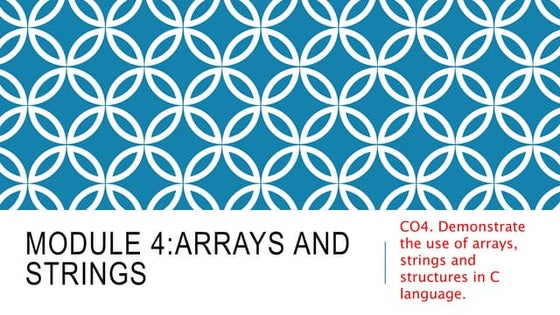



Module 4- Arrays and Stringsnikshaikh786
Ã˝
‚óè Introduction to Arrays
‚óè Declaration and initialization of one dimensional and two-dimensional
arrays.
‚óè Definition and initialization of String
‚óè String functionsCP Handout#7



CP Handout#7trupti1976
Ã˝
This document provides information on writing a C program to find the largest number in an array. It defines arrays and how they are declared and initialized. The document includes a flowchart and algorithm for the problem. It also includes the full C program code to find the largest number in an array by getting array size and elements from user input and iterating through the array to find the largest. It concludes by stating the learning outcomes were to declare arrays, draw a flowchart, write an algorithm, and write the program.2 arrays
- 1. Arrays
- 2. Arrays a series of elements of the same type placed in contiguous memory locations that can be individually referenced by adding an index to a unique identifier. e.g. we can store 5 values of type int in an array without having to declare 5 different variables, each one with a different identifier. Sample
- 3. What are Arrays? An array is a data structure which holds multiple variables of the same data type. An array is a multi-element box, a bit like a filing cabinet, and uses an indexing system to find each variable stored within it. In C++, indexing starts at zero . Arrays, like other variables in C++, must be declared before they can be used.
- 4. Array Structure num 0 1 2 3 4 Name of Array Index numbers
- 5. Declaring an ARRAY General Syntax: type name [elements]; Where: type is a valid type (like int , float ...) name is a valid identifier elements field (which is always enclosed in square brackets [ ]), specifies how many of these elements the array has to contain.
- 6. e.g. int sample [ 5 ]; The elements field within brackets [ ] which represents the number of elements the array is going to hold, must be a constant value, since arrays are blocks of non-dynamic memory whose size must be determined before execution. In order to create arrays with a variable length, dynamic memory is needed. Sample
- 7. Declaring Arrays #include <iostream.h> void main() { int numbers[100]; int averages[]= {10,20,30}; numbers[0] = 10; }
- 8. Initializing ARRAYS When declaring a regular array of local scope (within a function, for example), if we do not specify otherwise, its elements will not be initialized to any value by default, so their content will be undetermined until we store some value in them. Global and static arrays, on the other hand, are automatically initialized filled with zeros. In both cases, local and global, we have the possibility to assign initial values to each one of its elements by enclosing the values in braces { }.
- 9. int sample [5] = { 16, 2, 77, 40, 12071 }; The amount of values between braces { } must not be larger than the number of elements that we declare for the array between square brackets [ ]. When an initialization of values is provided for an array, C++ allows the possibility of leaving the square brackets empty [ ]. int sample [] = { 16, 2, 77, 40, 12071 }; 16 40 77 2 12071 Sample
- 10. Initializing Arrays #include <iostream.h> main() { int count; int values[100]; for( count = 0; count < 100; count++ ) values[count] = 10; }
- 11. Accessing the values of an ARRAY In any point of a program in which an array is visible, we can access the value of any of its elements individually as if it was a normal variable, thus being able to both read and modify its value. name[index] Sample[3] Sample[0] Sample[2] Sample[1] Sample[4] Sample
- 12. e.g., to store the value 75 in the third element of sample: sample[2] = 75 e.g., to pass the value of the third element of sample to a variable called a: a = sample[2];
- 13. An Array example int num[4]; num[0] = 101; num[1] = 232; num[2] = 231; num[3] = 0; The array num has a length of 4
- 14. Square brackets [ ] perform two different tasks: to specify the size of arrays when they are declared; to specify indices for concrete array elements. int sample[5]; // declaration of a new Array sample[2] = 75; // access to an element of the Array.
- 15. Some Valid Operations with Arrays sample[0] = a; sample[a] = 75; b = sample [a+2]; sample[sample[a]] = sample[2] + 5;
- 16. Sample Implementation: // arrays example #include <iostream.h> int sample [] = {16, 2, 77, 40, 12071}; int n, result=0; int main () { for ( n=0 ; n<5 ; n++ ) {result += sample[n];} cout << result; return 0;}
- 17. Programming Exercise: Create a program that allows input of integer values in an array and prints them in reverse order. The size of the array is 10. Sample Run: Input: 5,10,15,20,25,30,35,40,45,50… Output: … 50,45,40,35,30,25,20,15,10…
- 18. Programming Quiz: Translate the following algorithm to C++ source code: create an array with a maximum of 200 float elements; initialize. enter positive numbers (elements) into array. total all elements. get the average. scan the array (once again) count the number of elements with values greater than 10% above average. output results.
- 19. Character Sequences the C++ Standard Library implements a powerful string class, which is very useful to handle and manipulate strings of characters. However, strings can also be represented as plain arrays of char elements. e.g. char sampchar [20];
- 20. array of characters can store shorter sequences than its total length a special character is used to signal the end of the valid sequence: the null character , whose literal constant can be written as '\0' (backslash, zero). Hence, to initialize array of characters: char myword[] = { 'H', 'e', 'l', 'l', 'o', '\0' }; sampchar



